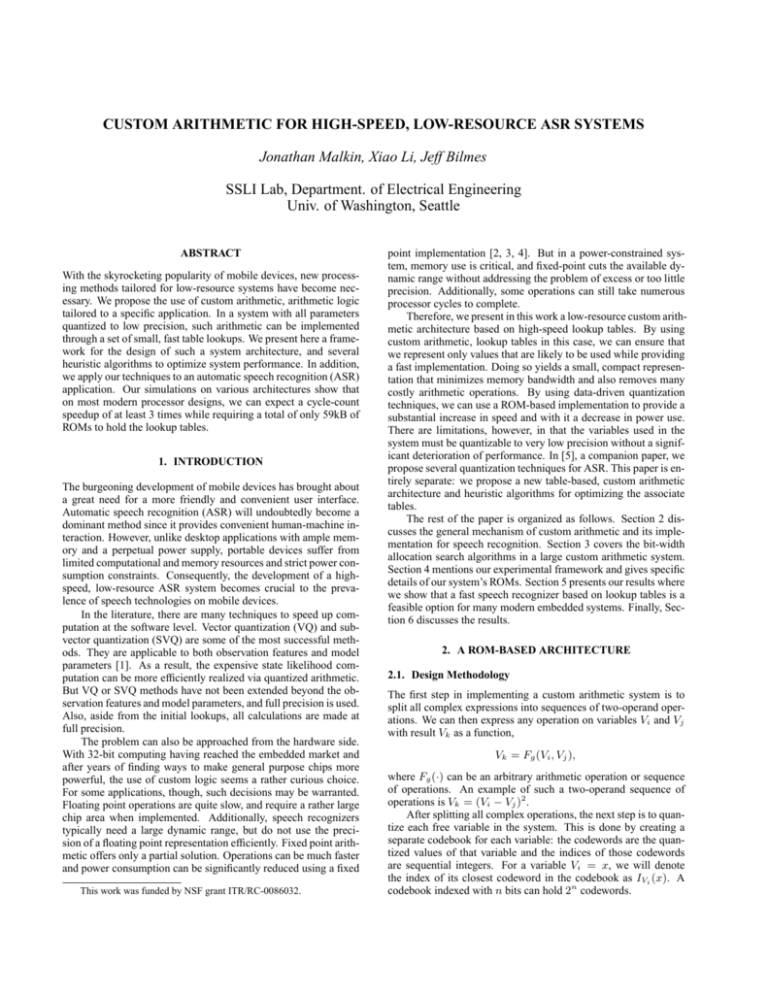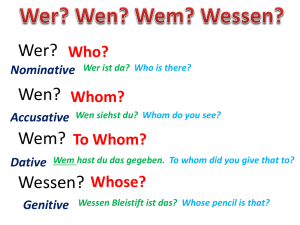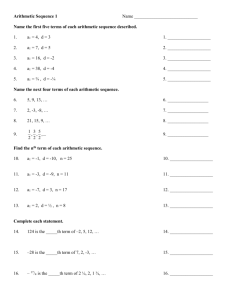CUSTOM ARITHMETIC FOR HIGH-SPEED, LOW
advertisement

CUSTOM ARITHMETIC FOR HIGH-SPEED, LOW-RESOURCE ASR SYSTEMS
Jonathan Malkin, Xiao Li, Jeff Bilmes
SSLI Lab, Department. of Electrical Engineering
Univ. of Washington, Seattle
ABSTRACT
With the skyrocketing popularity of mobile devices, new processing methods tailored for low-resource systems have become necessary. We propose the use of custom arithmetic, arithmetic logic
tailored to a specific application. In a system with all parameters
quantized to low precision, such arithmetic can be implemented
through a set of small, fast table lookups. We present here a framework for the design of such a system architecture, and several
heuristic algorithms to optimize system performance. In addition,
we apply our techniques to an automatic speech recognition (ASR)
application. Our simulations on various architectures show that
on most modern processor designs, we can expect a cycle-count
speedup of at least 3 times while requiring a total of only 59kB of
ROMs to hold the lookup tables.
1. INTRODUCTION
The burgeoning development of mobile devices has brought about
a great need for a more friendly and convenient user interface.
Automatic speech recognition (ASR) will undoubtedly become a
dominant method since it provides convenient human-machine interaction. However, unlike desktop applications with ample memory and a perpetual power supply, portable devices suffer from
limited computational and memory resources and strict power consumption constraints. Consequently, the development of a highspeed, low-resource ASR system becomes crucial to the prevalence of speech technologies on mobile devices.
In the literature, there are many techniques to speed up computation at the software level. Vector quantization (VQ) and subvector quantization (SVQ) are some of the most successful methods. They are applicable to both observation features and model
parameters [1]. As a result, the expensive state likelihood computation can be more efficiently realized via quantized arithmetic.
But VQ or SVQ methods have not been extended beyond the observation features and model parameters, and full precision is used.
Also, aside from the initial lookups, all calculations are made at
full precision.
The problem can also be approached from the hardware side.
With 32-bit computing having reached the embedded market and
after years of finding ways to make general purpose chips more
powerful, the use of custom logic seems a rather curious choice.
For some applications, though, such decisions may be warranted.
Floating point operations are quite slow, and require a rather large
chip area when implemented. Additionally, speech recognizers
typically need a large dynamic range, but do not use the precision of a floating point representation efficiently. Fixed point arithmetic offers only a partial solution. Operations can be much faster
and power consumption can be significantly reduced using a fixed
This work was funded by NSF grant ITR/RC-0086032.
point implementation [2, 3, 4]. But in a power-constrained system, memory use is critical, and fixed-point cuts the available dynamic range without addressing the problem of excess or too little
precision. Additionally, some operations can still take numerous
processor cycles to complete.
Therefore, we present in this work a low-resource custom arithmetic architecture based on high-speed lookup tables. By using
custom arithmetic, lookup tables in this case, we can ensure that
we represent only values that are likely to be used while providing
a fast implementation. Doing so yields a small, compact representation that minimizes memory bandwidth and also removes many
costly arithmetic operations. By using data-driven quantization
techniques, we can use a ROM-based implementation to provide a
substantial increase in speed and with it a decrease in power use.
There are limitations, however, in that the variables used in the
system must be quantizable to very low precision without a significant deterioration of performance. In [5], a companion paper, we
propose several quantization techniques for ASR. This paper is entirely separate: we propose a new table-based, custom arithmetic
architecture and heuristic algorithms for optimizing the associate
tables.
The rest of the paper is organized as follows. Section 2 discusses the general mechanism of custom arithmetic and its implementation for speech recognition. Section 3 covers the bit-width
allocation search algorithms in a large custom arithmetic system.
Section 4 mentions our experimental framework and gives specific
details of our system’s ROMs. Section 5 presents our results where
we show that a fast speech recognizer based on lookup tables is a
feasible option for many modern embedded systems. Finally, Section 6 discusses the results.
2. A ROM-BASED ARCHITECTURE
2.1. Design Methodology
The first step in implementing a custom arithmetic system is to
split all complex expressions into sequences of two-operand operations. We can then express any operation on variables Vi and Vj
with result Vk as a function,
Vk = Fg (Vi , Vj ),
where Fg (·) can be an arbitrary arithmetic operation or sequence
of operations. An example of such a two-operand sequence of
operations is Vk = (Vi − Vj )2 .
After splitting all complex operations, the next step is to quantize each free variable in the system. This is done by creating a
separate codebook for each variable: the codewords are the quantized values of that variable and the indices of those codewords
are sequential integers. For a variable Vi = x, we will denote
the index of its closest codeword in the codebook as IVi (x). A
codebook indexed with n bits can hold 2n codewords.
Once the codeword values for the inputs and the output are
known, all possible values for a function can be precomputed and
stored in a table. Each address in the table is determined by the
indices of the input operand codewords, and the output is the integer index of the result’s codeword. If the output and the two inputs
have bit-widths of n0 , n1 , and n2 , respectively, then the table requires a total storage of n0 · 2n1 +n2 bits. We will refer to the table
created for a function Fg (·) as TFg .
The final step in designing this custom arithmetic system is
to replace all floating-point values in the program with the corresponding integer indices, providing approximated computation for
all values. The calculation z = Fg (x, y) would therefore become
IVk = TFg (IVi , IVj ).
By storing the integer index of the codeword of the output
value, we reduce the storage requirements of the table. We can
also use the output index directly as the input of the next table
lookup, so that all data flow and storage are represented as lowprecision integers and all complex expressions become a series of
simple table lookups.
2.2. Design for ASR
The nature of the equations for decoding with a mixture of Gaussians CHMM (Continuous Hidden Markov Model) makes that task
particularly suited to our new method. For instance, part of calculating the Mahalanobis distance for the likelihood evaluation requires the equation given earlier, Vk = (Vi − Vj )2 . Rather than a
floating point subtraction followed by a floating point multiplication, this entire calculation could be completed with a single table
lookup.
Similarly, many ASR systems use log values to store probabilities. The addition of probabilities therefore requires log addition. Representing z = x + y in the log domain gives z̄ =
x̄ + log(1 + eȳ−x̄ ) where z̄, x̄, and ȳ are the logarithms of their
unlogged counterparts. Again, this calculation is a function with
two input operands meaning that a lookup can replace many operations, including the expensive calls to the log and exponential
library functions.
3. BIT ALLOCATION SEARCH ALGORITHMS
So far, we have discussed table construction, but have not addressed how to determine the size of each table. The goal is to
come up with a system-wide optimization algorithm to allocate
resources among all variables. We aim to find the bit-width allocation scheme which minimizes the cost of the resources while
maintaining baseline performance.
The algorithms will be presented for a system with L variables
{Vi }L
i=1 . We now make the following definitions:
• bwi – the bit-width of Vi . bwi can take on any integer
value below 32 (the number of bits used for single-precision
floating-point representation);
• fp – when bwi = fp, Vi is unquantized. Typically, fp =
32;
~ = (bw1 , bw2 , ..., bwL ) – a bit-width allocation scheme;
• bw
~ i – an increment of 1 bit for variable Vi , where bw
~ +
• ∆bw
~ i = (bw1 , ..., bwi + 1, ..., bwL );
∆bw
~ – the word error rate (WER) evaluated at bw;
~
• wer(bw)
~ – total cost of resources evaluated at bw.
~
• cost(bw)
Note that the cost function can be arbitrarily defined depending on the specific goals of the allocation. In this paper, we use the
total storage of the tables as the cost. Additionally, we define the
gradient δi as the ratio of the decrease in WER to the increase in
cost evaluated in the direction of bwi .
∆
~ =
δi (bw)
~ − wer(bw
~ + ∆bw
~ i)
wer(bw)
~ + ∆bw
~ i ) − cost(bw)
~
cost(bw
(1)
Equation (1) reflects the rate of improvement along the bwi direction. We can extend this definition to the gradient along multiple
directions. For example,
∆
~ =
δij (bw)
~ − wer(bw
~ + ∆bw
~ i + ∆bw
~ j)
wer(bw)
~ + ∆bw
~ i + ∆bw
~ j ) − cost(bw)
~
cost(bw
(2)
is the gradient in the joint direction of bwi and bwj .
∆
Assuming the baseline system gives a WER of BWER =
~
wer(bw)|bw=(fp,fp,...,fp)
+ with > 0 a tolerance for increased
~
error due to quantization, our goal can be interpreted as
~∗ =
bw
argmin
~
cost(bw)
(3)
~
~
bw:wer(
bw)≤
BWER
This search space is highly discrete and, due to the effects of quantization noise, only approximately smooth. The combination of
these factors means the optimization is very difficult. An exhaus~ ∗ , evaluating wer(bw)
~ and cost(bw)
~ at every
tive search for bw
~
possible bw, is clearly exponential in L. Even constraining the
bit-width of each variable to a restricted range of possibile values
gives a very large search space. In the following subsections, we
present several heuristics that work well experimentally. The basic
~ that has low enough a WER
idea is that we start with a low-cost bw
that gradients are not meaningless (they provide no information if
bit widths are too low) and greedily increase the bit-widths of one
or a small group of variables until we find an acceptable solution.
This is similar to the method used in [6] to optimize floating-point
bit-widths.
3.1. Single-variable quantization
Finding a reasonable starting point is an important part of these
algorithms. One logical place to start is with the results of singlevariable quantization, since the results of those quantizations are
needed in order to create the tables. Specific methods for quantizing the variables are beyond the scope of this paper. For those
interested in several quantization techniques specific to ASR that
we developed, see [5].
In general, it is expected that the noise introduced into the system by quantizing an additional variable will produce a result that
is not better than without the extra variable quantized. For that
reason, we take the starting point to be the minimum number of
bits needed to quantize a single variable to produce baseline WER
results. We call that result mi , the minimum bit-width of variable
Vi . We determine an upper bound Mi based on inspection.
Once we determine the boundaries for each single variable we
have constrained our search for an optimal point to the hypercube
~ i ≤ Mi , i = 1..L. It then makes sense
bounded by mi ≤ bw
~ init = (bw1 =
to start each of the following algorithms at bw
m1 , bw2 = m2 , ..., bwL = mL ). In all cases, it is assumed that
~ init ) > BWER since the algorithms are designed to stop
wer(bw
~ with a WER as low as the target rate.
when they have found a bw
3.2. Single-dimensional increment based on static gradients
This is the simplest, most naive algorithm. In it, we allow one variable’s bit-width to increment by 1 each iteration, based on static
~ ~
gradients, δis (bwi ) = δi (bw)|
bw=(fp,...,bwi ,...,fp) . The static gradients are obtained from the results of single-variable quantization,
with all other variables at fp. The algorithm is:
1. Compute the static gradients δis (bwi ), i = 1..L at point
~ based on the WERs of the single-variable quantization.
bw,
Choose the direction k = argmax δis (bwi ), and increase bwk
i
by one if it does not exceed the upper bound Mk ;
~
~ ≤ BWER
2. Run a test to get the new wer(bw).
If wer(bw)
~ ∗ = bw
~ or, if there is no improvement in WER
return bw
~ ∗ = bw;
~
observed, undo the increment before returning bw
otherwise repeat step 1.
In this case, the static gradient is used to approximate the true
gradient. The gradients can therefore be pre-computed from the
single-variable quantization results, but may be inaccurate. This
method gives a pre-determined sequence to test, so the task becomes checking the WER at each point until we have a satisfactory
one.
3.3. Single-dimensional increment with dynamic gradients
This algorithm, like the first one, allows only single-dimensional
~ as a measure of
increments, but it uses the true gradient δi (bw)
improvement, requiring online evaluation. The steps are:
~ i = 1..L for the current bw
~
1. Evaluate the gradients δi (bw),
according to Equation (1), where L tests are needed to obtain
the WERs;
~ and increase bwk
2. Choose the direction k = argmax δk (bw),
i
by one if bwk + 1 ≤ Mk ;
~
~ ≤ BWER
3. Run a test to get the new wer(bw).
If wer(bw)
∗
~ = bw
~ or, if there is no improvement in WER
return bw
~ ∗ = bw;
~
observed, undo the increment before returning bw
otherwise repeat step 1.
For speech recognition, online evaluation for a test takes a significant amount of time, requiring a full test cycle (although not
retraining). This algorithm consequently takes much more time to
complete than does the first one. As this takes place during the
design stage, this is not a problem; at recognition time there is no
penalty.
~ at each step which gives true
This algorithm updates δi (bw)
gradients in the L-dimensional space. It might be the case that no
improvement exists along each of the L directions, but that one
does exist with joint increments along multiple dimensions. With
this algorithm, the search might become stuck in a local optimum.
3.4. Multi-dimensional increment with dynamic gradients
Finally, the bit-widths of multiple variables could be increased in
parallel. Considering the computational complexity, we only allow
L
one- or two-dimensional increments, leading to L +
possible
2
candidates. We could extend this to include triple increments, but
it would take an intolerably long time to finish. The algorithm
modifies steps 1 and 2 from the above algorithm as follows:
~ and δij (bw),
~ i = 1..L, j =
1. Evaluate the gradients δi (bw)
~
1..L on current bw according
to Equations (1) and (2) reL
spectively, where L +
tests are needed to obtain the
2
WERs;
2. Choose the direction k or a pair of directions {k, l} where
~ or δkl (bw)
~ is the maximum among all the singleδk (bw)
dimensional and pair-wise increments. Increase the bitwidth of Vk or those of {Vk , Vl } by one if no one exceeds
its upper bound.
This algorithm is superior to the previous two in the sense that
it explores many more candidate points in the search space. It
considers only one additional direction and may still fall into a
local optimum, but is less likely to do so than in the previous case.
Due to the measures it takes to avoid local optima, this algorithm
takes substantially longer to complete. Again, this is acceptable
since it happens during the design stage, not during recognition.
4. EXPERIMENTAL FRAMEWORK
4.1. Speech Recognizer
Our ASR system uses the NYNEX PhoneBook [7] database for
training and testing. It is designed for isolated-word recognition
tasks and consists of 93,667 isolated-word utterances recorded over
a telephone channel with an 8,000 Hz sampling rate. Each sample
is encoded with 8 bits via µ-law. For details of the training and
testing sets, see [8].
We use standard MFCCs plus log energy and their deltas, yielding 26-dimensional acoustic feature vectors. Each vector has mean
subtraction and variance normalization applied to both static and
dynamic features.
The word model is a set of phone-based CHMMs concatenated
together into words based on pronunciation. These pronunciation
models determine the transition probabilities between phones. Doing this provides a customizable vocabulary without the need for
retraining, a desirable goal for an embedded device.
The system has 42 phone models, each composed of 4 emitting
states except for the silence model. The state probability distribution is a mixture of 12 diagonal Gaussians.
4.2. Lookup Tables
We simulated lookup table implementation using SimpleScalar [9],
an architecture-level execution-driven simulator. All tables were
pre-calculated by SimpleScalar at runtime. We extended the instruction set and modified the assembler to support new lookup
instructions. Our tables use a total of 13 variables for 8 functions,
6 in the likelihood evaluation and 2 in the Viterbi search. In most
cases, quantized bit-widths were restricted to between 1 and 10
bits.
We simulated results for a variety of architectures. The first
is the SimpleScalar default configuration, roughly akin to a 3rd
generation Alpha, an out-of-order superscalar processor. The second represents a more modern desktop machine; cache sizes and
latencies have been updated from the defaults to reflect more current values. Our third configuration attempts to represent a typical high-end DSP chip. Since most DSP chips are VLIW, an architecture feature not replicable with SimpleScalar, we chose instead to force in-order execution as a very rough approximation of
VLIW. Finally, we simulated a very simple processor with a single
pipeline and no cache. In each case, we allowed multiple tables to
be accessed in parallel, although a specific table could be used by
only 1 instruction at a time.
4
SimpleScalar Default
Modern Desktop
3.5
High-end DSP
5.1. Allocation Search Algorithms
The results of running each allocation algorithm appear in Table 1.
The baseline WER for the system was 2.07%.
1-D, static δ
1-D, dynamic δ
2-D, dynamic δ
Min WER
3.01%
3.09%
2.53%
Table Size (kB)
94.00
36.44
58.75
Points Tested
13
52
454
Table 1. Minimum WER, total table size, and points tested for
each algorithm
Not too surprisingly, the 1-D, static gradient algorithm did not
perform particularly well. It managed to reach a slightly better
WER than did the 1-D dynamic gradient algorithm, but it required
several times more storage to do so. It reached a local optimum
quickly, after trying only 13 configurations. The 1-D dynamic gradient algorithm tested a total of 52 configurations, managing to
find a fairly small ROM size. The non-linear nature of the search
space posed problems for this algorithm, though, which is likely
why its WER was the highest. Finally, the 2-D dynamic gradient
algorithm found a much better WER than the other two algorithms,
even if its total table size was not the smallest. Although the final
result does not reach the baseline, it gives an acceptable WER, especially when considering the potential speedup, as is done next.
5.2. Lookup Tables
We simulated each of the target machines for a range of lookup table speeds. This is independent of WER since, assuming the table
is not too large, the precision of the output of a lookup has little to
do with the speed of the lookup. Because we did not try to implement a low-power front-end, a feature that would be necessary for
a final realization of this system, we used pre-calculated MFCCs
and subtracted initialization time when calculating speedup. Figure 1 shows the speedup obtained versus the number of cycles required for each lookup. The speedup ranges from just under 2.5
to nearly 4 when lookups take only 1 cycle, and falls off as they
become more expensive. In all cases, the speedup is quite significant even when lookups cost several cycles. If the ROM tables are
small enough to fit on the processor chip, which is the case using
the 59kB results from Table 1, a 1-cycle lookup is quite realistic
for a state-of-the-art system. Much benefit actually comes from
replacing sequences of instructions with a single lookup, as the
dynamic instruction count fell nearly as much as execution time.
6. DISCUSSION
In this paper, we have presented a methodology for the design of
high-speed, low-resource systems using custom arithmetic. We
also demonstrate several resource allocation search heuristics suitable for finding acceptable points in an otherwise intractable search
space. We then applied our findings to a CHMM-based ASR system. Using the allocation search algorithms we developed, we
found a table configuration giving satisfactory performance with
only a small additional amount of storage. The 59kB of tables is
Speedup over Baseline
Simple Processor
5. RESULTS
3
Baseline (unquantized)
2.5
2
1.5
1
0.5
0
1
2
3
4
5
6
7
8
Cycles per ROM Lookup
Fig. 1. Speedup (in cycles) over baseline versus cycles per ROM
lookup. Baseline uses 32-bit floating point values and no lookups.
small enough that it can be added to any chip with an access time
of 1 cycle. When implementing this design on a modern processor, we show that the expected speedup is at least 3, and possibly
larger. Additionally, the smaller operand size means we can make
more efficient use of caches to reduce cache misses, and could
even narrow the memory bus width providing savings in both chip
area and power consumption.
We would like to thank Chris Bartels and Gang Ji for proofreading and Carl Ebeling for much helpful advice.
7. REFERENCES
[1] K.Filali, X.Li, and J.Bilmes, “Data-driven vector clustering
for low-memory footprint ASR,” in Proc. Int. Conf. on Spoken
Language Processing, 2002, pp. 1601–1604.
[2] Y.Gong and U.-H.Kao, “Implementing a high accuracy
speaker-independent continuous speech recognizer on a fixed
DSP,” in IEEE ICASSP, 2000, pp. 3686–3689.
[3] E.Cornu, N.Destrez, A.Dufaux, H.Sheikhzadeh, and R.Bren
nan, “An ultra low power, ultra miniature voice command
system based on hidden markov models,” in IEEE ICASSP,
2002, vol. 4, pp. 3800–3803.
[4] I.Varga and et.al., “ASR in mobile phones – An industrial
approach,” IEEE Trans. on Speech and Audio Processing, vol.
10, no. 8, pp. 562–569, 2002.
[5] X.Li, J.Malkin, and J.Bilmes, “Codebook design for ASR
systems based on custom arithmetic,” in IEEE ICASSP, 2004.
[6] F.Fang, T.Chen, and R.A.Rutenbar, “Floating-point bit-width
optimization for low-power signal processing applications,” in
IEEE ICASSP, 2002, pp. 3208–3211.
[7] J.F.Pitrelli, C.Fong, and H.C.Leung,
“PhoneBook: A
phonetically-rich isolated-word telephone-speech database,”
in IEEE ICASSP, 1995.
[8] J.A.Bilmes, “Buried Markov models for speech recognition,”
in IEEE ICASSP, 1999.
[9] Doug Burger, Todd M. Austin, and Steve Bennett, “Evaluating
future microprocessors: The simplescalar tool set,” Tech. Rep.
CS-TR-1996-1308, 1996.





![Information Retrieval June 2014 Ex 1 [ranks 3+5]](http://s3.studylib.net/store/data/006792663_1-3716dcf2d1ddad012f3060ad3ae8022c-300x300.png)

